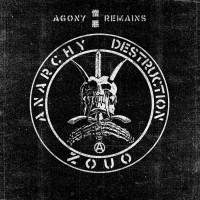Until recently, the only audio documentation of Japan’s Zouo were their only release, The Final Agony 7-inch EP and two tracks on the Hardcore Unlawful Assembly compilation. Today, people talk about them as icons, common as say, Poison Idea, but until the age of the Internet, this band was barely known, if known at all. Good luck finding a limited press Japanese 7-inch from 1984 in the states mid ‘90s. In fact, the band really only sort of rose from the deepest murk into wider consciousness in the early 2010s when the Japanese Crust War label released some archival material, thereby granting the band somewhat of a wider recognition, as aided by fiberoptic transmission.
Relapse’s Agony Remains seems to not only act as the band’s first USA release ever, but to act as a comprehensive, informed document of the band’s entire existence. It succeeds.
The release bundles up all six of the band’s studio tracks and adds 36 live recordings, featuring many tracks that never got a studio treatment. Zouo is often compared to GISM and the comparison is apt. Like GISM, Zouo pulled directly from a few different sources- anarcho punk, thrash, glam metal - and welded them into something strange. Frontman Cherry Nishida growled in a combination of UK Subs blowout and black metal menace. Guitarist Milky, who is also in the Zouo successor bands S.H.I. with Nishida, added a grimy, thrash roar, equally focused on sounding huge as well as, frankly, catchy. These tracks are snappy. “No Power” features a Discharge-style blast that is distorted to the extend where one note bleeds into the next, but keeps an effective strike.
Like GISM, there is lyrical discord here. I don’t really know what “No power” is about. Is that due to a translation issue, or is that due to purposeful ambiguity. Does it matter? Because the band’s sound is built on a collision of styles, why shouldn’t the ;lyrics be a collision of words- suggesting some sort of menace without giving strict detail. In fact, the ambiguity and bent meanings here often cause a sort of a more artful threats than, say, many death metal band’s where a Jason-like butchering is detailed step by step. Nishida does interestingly blend Japanese culture with Western thought and religion - “making love with devil” is about having sex with Satan, I think. You can bend that idea in many different ways - is it grotesque? Funny? Beautiful? The band specifically doesn’t spell it out and that’s probably why these lyrics have confounded, and inspired, thousands of bands over the decades.
Yet, whereas GISM seemed to be completely off the wall and perhaps the result of insanity, Zouo seem to handle their tools with more precision (either methods can and do work wonders). But here, Zouo seems firmly aware of the horror concepts developed by Venom and the power of Discharge primal blast and use those tools to great effect. “You like it that way” swings in a boogie-woogie swagger (think biker bar) before Nishida enters with his death growl. Who knows if the band had a blueprint laid out before recording, but despite the various pieces here, everything seems to be laid out with precision and is probably why bands are still copying this band directly, to this day. Zouo seems to have pulled the clever trick of being dedicated and knowledgeable to their influences, but also having a disregard for “rules,” which in the ‘80s, were very codified in punk rock. That’s the reason this band is now iconic.
The live recordings from 1983 and 1984 waiver between being archival documents and music for listening enjoyment. Both are likely bootleg recordings and the 1983 sound is particularly rough. THe 1984 recording is a bit better, though the vocals are often buried in the mix. A better sound recording would have been nice, but alas, it doesn’t exist, so better to at least record these long lost songs than to discard them. If anything, both live sets show that the band was tight, but furious live- equally interested in their off kitler approach as trying to blow the door off the venue. The Live at studio Ahiru set, which closes the release, is the best sounding of the three releases and more closely resembles a proper live album. There’s no major revelation- though, the band rocks at full speed and tears through their meaning numbers with extra menace. The studio recordings will always define the band, but the live additions are indeed nice additions.
Perhaps surprisingly, while Agony Remains is a thorough, comprehensive document of the band, it doesn’t answer many of the questions about them and their weirdness that has sustained for decades. That’s as it should be.
